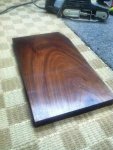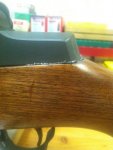

I'll simply share some methods of stock finishing / re-finishing - those I have used and those I have studied but have yet to use, but without distinguishing between the two to keep it simple. I use only pure Tung Oil, as opposed to Tung OIl Finish, and here is what I do:
1.) Remove the old finish using Jasco Paint and Epoxy Remover, semi-paste, and following instructions generally on the product, using #3 steel wool, and wire brushes of varying bristles for sharp corners and checkering. Some worry about damaging checkering. Checkering is already damaged on these stocks. Scrubbing them clean of dirt and old finish only brings out the checkering whether one might re-cut or not. I throw in the matter of checkering having done some Browning A-5 stocks. I know vintage rifle stocks don't have checkering.
2.) Stocks do not absorb Jasco Paint and Epoxy Remover. Therefore, I go right on into preparing for oiling by raising dents with boiling water poured onto the dents. Allow wood to dry thoroughly indoor, or outdoor in arid climates and indoor in damp ones. Near El Paso, where I've been for a spell, a few hours outdoor will suffice. Here in Louisiana, drying will require all day indoor. Not concerned with dents, I skip hot water and begin light sanding using a block and, depending on the surface condition of the wood, 180 - 400 grit paper. In curves like the pistol grip paper wrapped around a balled up rag works. Sanding with the hand will develop waves in the surface along the soft wood portions between the harder wood portions. Bad.
Combining any position that works with laying the stock flat on a stout table surfaced with carpeting or yoga mat material, sand along the grain, parallel to the length of the stock. If the stock was really rough and you began with a course grit, progress to the next 100 grit finer paper for another go, again along the grain, until you have progressed to 400 grit. Always sand parallel to the grain except when filling during the oiling stage, or with filler. I've yet to fill the grain before oiling. I don't like darkening the wood as much as filler seems to in the stocks I've seen. Sand with the grain with a sanding block with grit that seems to achieve the goal. The wood is difficult to ruin at this point, but easy to create more work by beginning too course, etching the surface, which will require deep sanding to remove.
3) Apply oil based, or alcohol based, stain to the wood in whatever color you wish. I like red (Cabot's, Minwax, Art's French Red Stain) on my Garand stock. Chestnut is one some like. Midway has Classic Stain in English Red and Gold Brown. I used Rustoleum Cabernet and I should have applied two coats. Successive sanding and oil applications absorbed some of the red I hoped would remain. Stain the stock using a method consistent with the successive oil or varnish you plan. Upon staining, I wasted no time going to the next step.
4.) Combine equal parts mineral spirits (or turpentine) and warmed, Pure Tung Oil (place your oil near the oven where little missy is baking your cookies). Apply spirits and oil combination to the also warmed wood directly with the fingers using circular motions one drop at a time on small areas, and then to even out the oil, with four fingers along the grain. Use rubber gloves if you wish, but I use bare skin so I can feel the wood and oil's texture, when the oil is becoming tacky, which means move on or apply more oil.
Allow oil to set 15 to 25 minutes depending on environmental conditions. With a clean, reasonably lent-free cloth like a shop rag or flannel cloth, wipe excess oil from the wood. Along the grain is probably better. Allow the wood to cure, absorbing the oil for a day or two. Lay the rag out flat, or rinse with spirits. I have heard of spontaneous combustion for wadded, oily rags, though I doubt it would happen.
5.) The second application of oil is accomplished with a different method than the first. Using 0000 steel wool, buff the surface along the grain. After buffing, using 400 grit paper and a sanding block, rub in this application of oil in either a circular, or strokes perpendicular to the grain motion to fill pores with sanded off wood dust. I combine spirits and oil on only the first application. If the oil and wood are not too cold and humid the desired affect will occur.
6.) Repeat step 5, as well as ever how many successive steps you wish, progressing to the next finer grit paper. On my last one I went up to 1500. Apply the same way as in #5. Set 15 to 25 minutes. Remove excess. Then set one or two days. Buff with 0000 wool preparing the surface for the next application of rubbed in Tung Oil.
Boiled Linseed oil might achieve the same result. I haven't tried it. My reading suggests Pure Tung Oil achieves the better result.
Shellac and paste wax achieves a nice antique finish. I used this method on a Rem Mod 11.
Also, I have applied sanding sealer to prepare the wood for applications of automotive transparent which can be buffed to lesser gloss level using 0000 steel wool or pumice/baking soda, or rubbing compound. Automotive wax and rubbing compounds can then vary the level of sheen or luster one might seek, even removing shine for hunting but returning the shine for showing. Wood is so much prettier than polymer, composite or fiberglass, but those stocks have their place too. For vintage guns, we stay with oil on wood. I am surprised pleasantly with a Garand stock I"m doing now. The appearance is taking on a sort of multi-dimensional, iridescent shine. Wood can be attractive.
Remove finish.
Sand.
Stain.
Wool buff.
Oil
Set.
Buff.
Oil
Set
Buff. Or not.
Peace,
Casey Simpson
P.S. Pictures of stocks in varying levels of finish are posted under my name here on the hide if pictures will help.
Attachments
Last edited:

